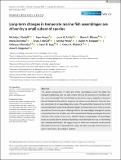Long-term changes in temperate marine fish assemblages are driven by a small subset of species
Abstract
The species composition of plant and animal assemblages across the globe has changed substantially over the past century. How do the dynamics of individual species cause this change? We classified species into seven unique categories of temporal dynamics based on the ordered sequence of presences and absences that each species contributes to an assemblage time series. We applied this framework to 14,434 species trajectories comprising 280 assemblages of temperate marine fishes surveyed annually for 20 or more years. Although 90% of the assemblages diverged in species composition from the baseline year, this compositional change was largely driven by only 8% of the species` trajectories. Quantifying the reorganization of assemblages based on species shared temporal dynamics should facilitate the task of monitoring and restoring biodiversity. We suggest ways in which our framework could provide informative measures of compositional change, as well as leverage future research on pattern and process in ecological systems.
Citation
Gotelli , N J , Moyes , F , Antão , L H , Blowes , S A , Dornelas , M , McGill , B J , Penny , A , Schipper , A , Shimadzu , H , Supp , S R , Waldock , C A & Magurran , A E 2021 , ' Long-term changes in temperate marine fish assemblages are driven by a small subset of species ' , Global Change Biology , vol. Early View . https://doi.org/10.1111/gcb.15947
Publication
Global Change Biology
Status
Peer reviewed
ISSN
1354-1013Type
Journal article
Description
Funding: Jane and Aatos Erkko Foundation (LHA); Japan Society for the Promotion of Science (JP19K21569) (HS); Leverhulme Trust (RPG-2019-402) (AEM, MD, FM, AP); Leverhulme Trust Research Centre - the Leverhulme Centre for Anthropocene Biodiversity (MD); USA National Science Foundation grant 2019470 (BJM, NJG); USA National Science Foundation/ UKRI Natural Environment Research Council grant NE/V009338/1 (MD).Collections
Items in the St Andrews Research Repository are protected by copyright, with all rights reserved, unless otherwise indicated.

